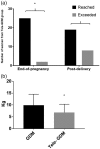Management of postprandial hyperglycaemia and weight gain in women with gestational diabetes mellitus using a novel telemonitoring system
- PMID: 30442052
- PMCID: PMC6381491
- DOI: 10.1177/0300060518809872
Management of postprandial hyperglycaemia and weight gain in women with gestational diabetes mellitus using a novel telemonitoring system
Abstract
Objectives: The purpose of this study was to investigate the effect of remotely delivered telemedicine dietary advice on monitoring of blood glucose levels and weight gain of women with gestational diabetes mellitus (GDM).
Methods: Women with GDM were recruited and randomly allocated into two groups: a Tele-GDM group that received a telemonitoring device, and a control group that was followed-up traditionally. A telemonitoring service calculated the ratio of reaching or exceeding the pregnancy weight gain target (according to pre-pregnancy weight), following Institute of Medicine guidelines for healthy pregnancy weight gain.
Results: The sample comprised 27 women in the Tele-GDM group and 30 in the control group. At the end of pregnancy, the Tele-GDM group showed significantly lower 2-hour postprandial glucose levels than the control group. Most women in the Tele-GDM group reached their recommended range of weight gain at the end of pregnancy. Additionally, the Tele-GDM group showed significantly lower weight gain than the control group.
Conclusions: Telemonitoring can facilitate close monitoring of women with GDM and motivate patients to adopt a healthy lifestyle.
Keywords: Gestational diabetes mellitus; gestational weight gain; hyperglycaemia; telediabetes; telemedicine; telemonitoring.
Figures




Similar articles
-
Evaluating the effects of mobile health intervention on weight management, glycemic control and pregnancy outcomes in patients with gestational diabetes mellitus.J Endocrinol Invest. 2019 Jun;42(6):709-714. doi: 10.1007/s40618-018-0975-0. Epub 2018 Nov 7. J Endocrinol Invest. 2019. PMID: 30406378 Clinical Trial.
-
Patterns of weight gain in pregnant women with and without gestational diabetes mellitus: an observational study.Aust N Z J Obstet Gynaecol. 2012 Oct;52(5):433-9. doi: 10.1111/ajo.12001. Aust N Z J Obstet Gynaecol. 2012. PMID: 23045986
-
Weight gain measures in women with gestational diabetes mellitus.J Womens Health (Larchmt). 2011 Mar;20(3):375-80. doi: 10.1089/jwh.2010.2252. Epub 2011 Feb 19. J Womens Health (Larchmt). 2011. PMID: 21332414
-
Prevention of gestational diabetes mellitus: a review of studies on weight management.Diabetes Metab Res Rev. 2010 Jan;26(1):17-25. doi: 10.1002/dmrr.1053. Diabetes Metab Res Rev. 2010. PMID: 19943327 Review.
-
Controversies in gestational diabetes.Best Pract Res Clin Obstet Gynaecol. 2011 Feb;25(1):37-49. doi: 10.1016/j.bpobgyn.2010.10.004. Epub 2010 Nov 5. Best Pract Res Clin Obstet Gynaecol. 2011. PMID: 21115402 Review.
Cited by
-
Gestational Diabetes in the Arab Gulf Countries: Sitting on a Land-Mine.Int J Environ Res Public Health. 2020 Dec 11;17(24):9270. doi: 10.3390/ijerph17249270. Int J Environ Res Public Health. 2020. PMID: 33322416 Free PMC article. Review.
-
Effects of a Telenutrition Weight Loss Program Supported with Telemonitoring and Telehealth Coaching on Anthropometric and Biochemical Measures in Overweight and Obese Adults: A Pilot Randomized Controlled Trial.Healthcare (Basel). 2024 Nov 25;12(23):2362. doi: 10.3390/healthcare12232362. Healthcare (Basel). 2024. PMID: 39684984 Free PMC article.
-
Development and Testing of a Mobile App for Management of Gestational Diabetes in Nepal: Protocol for a User-Centered Design Study and Exploratory Randomized Controlled Trial.JMIR Res Protoc. 2024 Oct 21;13:e59423. doi: 10.2196/59423. JMIR Res Protoc. 2024. PMID: 39432898 Free PMC article.
-
The Effect of Smartphone Application-Based Self-Management Interventions Compared to Face-to-Face Diabetic Interventions for Pregnant Women With Gestational Diabetes Mellitus: A Meta-Analysis.J Diabetes Res. 2025 Mar 1;2025:4422330. doi: 10.1155/jdr/4422330. eCollection 2025. J Diabetes Res. 2025. PMID: 40225011 Free PMC article.
-
Digital health interventions for gestational diabetes mellitus: A systematic review and meta-analysis of randomised controlled trials.PLOS Digit Health. 2022 Feb 24;1(2):e0000015. doi: 10.1371/journal.pdig.0000015. eCollection 2022 Feb. PLOS Digit Health. 2022. PMID: 36812531 Free PMC article.
References
-
- Reece EA, Moore T. The diagnostic criteria for gestational diabetes: to change or not to change? Am J Obstet Gynecol 2013; 208: 255–259. - PubMed
-
- World Health Organization. Diagnostic criteria and classification of hyperglycaemia first detected in pregnancy: a world health organization guideline. Diabetes Res Clin Pract 2014; 103: 341–363. - PubMed
-
- Lain KY, Catalano PM. Metabolic changes in pregnancy. Clin Obstet Gynecol 2007; 50: 938–948. - PubMed
MeSH terms
LinkOut - more resources
Full Text Sources
Medical

